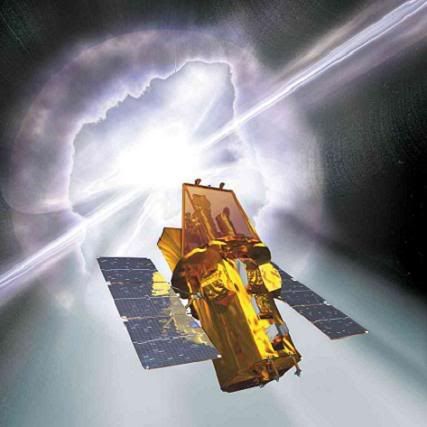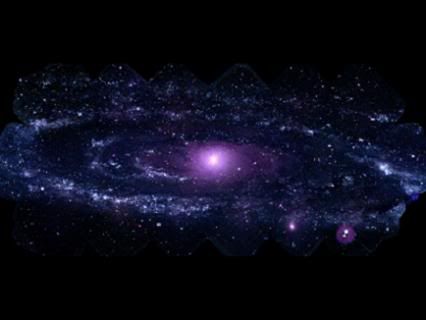Post by glactus on Sept 23, 2009 2:42:01 GMT
Swift Makes Best-Ever Ultraviolet Portrait of Andromeda Galaxy.

The Swift Space observatory
In a break from its usual task of searching for distant cosmic explosions, NASA's Swift satellite has acquired the highest-resolution view of a neighboring spiral galaxy ever attained in the ultraviolet. The galaxy, known as M31 in the constellation Andromeda, is the largest and closest spiral galaxy to our own.

The Andromeda galaxy
This mosaic of M31 merges 330 individual images taken by the Ultraviolet/Optical Telescope aboard NASA's Swift spacecraft. It is the highest-resolution image of the galaxy ever recorded in the ultraviolet. The image shows a region 200,000 light-years wide and 100,000 light-years high.
"Swift reveals about 20,000 ultraviolet sources in M31, especially hot, young stars and dense star clusters," said Stefan Immler, a research scientist on the Swift team at NASA's Goddard Space Flight Center in Greenbelt, Md. "Of particular importance is that we have covered the galaxy in three ultraviolet filters. That will let us study M31's star-formation processes in much greater detail than previously possible."
M31, also known as the Andromeda Galaxy, is more than 220,000 light-years across and lies 2.5 million light-years away. On a clear, dark night, the galaxy is faintly visible as a misty patch to the naked eye.
Several features are immediately apparent in the new mosaic. The first is the striking difference between the galaxy's central bulge and its spiral arms. "The bulge is smoother and redder because it's full of older and cooler stars," Immler explained. "Very few new stars form here because most of the materials needed to make them have been depleted."
Dense clusters of hot, young, blue stars sparkle beyond the central bulge. As in our own galaxy, M31's disk and spiral arms contain most of the gas and dust needed to produce new generations of stars. Star clusters are especially plentiful in an enormous ring about 150,000 light-years across.
"Swift is surveying nearby galaxies like M31 so astronomers can better understand star- formation conditions and relate them to conditions in the distant galaxies.

Credits: These are NASA omages NASA/Swift/Stefan Immler (GSFC) and Erin Grand (UMCP
Text: see full text at Space daily.com
www.spacedaily.com/reports/Swift_Makes_Best_Ever_Ultraviolet_Portrait_of_Andromeda_Galaxy_999.html

The Swift Space observatory
In a break from its usual task of searching for distant cosmic explosions, NASA's Swift satellite has acquired the highest-resolution view of a neighboring spiral galaxy ever attained in the ultraviolet. The galaxy, known as M31 in the constellation Andromeda, is the largest and closest spiral galaxy to our own.

The Andromeda galaxy
This mosaic of M31 merges 330 individual images taken by the Ultraviolet/Optical Telescope aboard NASA's Swift spacecraft. It is the highest-resolution image of the galaxy ever recorded in the ultraviolet. The image shows a region 200,000 light-years wide and 100,000 light-years high.
"Swift reveals about 20,000 ultraviolet sources in M31, especially hot, young stars and dense star clusters," said Stefan Immler, a research scientist on the Swift team at NASA's Goddard Space Flight Center in Greenbelt, Md. "Of particular importance is that we have covered the galaxy in three ultraviolet filters. That will let us study M31's star-formation processes in much greater detail than previously possible."
M31, also known as the Andromeda Galaxy, is more than 220,000 light-years across and lies 2.5 million light-years away. On a clear, dark night, the galaxy is faintly visible as a misty patch to the naked eye.
Several features are immediately apparent in the new mosaic. The first is the striking difference between the galaxy's central bulge and its spiral arms. "The bulge is smoother and redder because it's full of older and cooler stars," Immler explained. "Very few new stars form here because most of the materials needed to make them have been depleted."
Dense clusters of hot, young, blue stars sparkle beyond the central bulge. As in our own galaxy, M31's disk and spiral arms contain most of the gas and dust needed to produce new generations of stars. Star clusters are especially plentiful in an enormous ring about 150,000 light-years across.
"Swift is surveying nearby galaxies like M31 so astronomers can better understand star- formation conditions and relate them to conditions in the distant galaxies.
Credits: These are NASA omages NASA/Swift/Stefan Immler (GSFC) and Erin Grand (UMCP
Text: see full text at Space daily.com
www.spacedaily.com/reports/Swift_Makes_Best_Ever_Ultraviolet_Portrait_of_Andromeda_Galaxy_999.html


